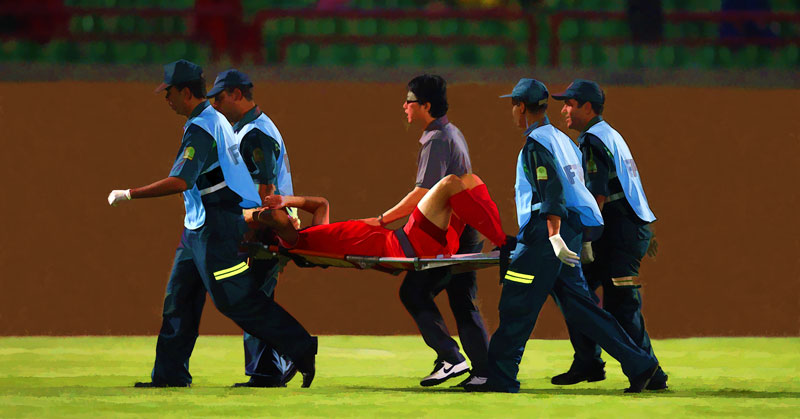
By Carl Valle
Many interesting online discussions focus on injuries and the best ways to get athletes better as they recover. Some experts focus on biomechanics, others on posture, and a few obsess with pain science. But hardly anyone deals with psychology. Athletes are much more likely to hear a lecture from a sleep expert than talk to a respected sports psychologist.
This article, therefore, is about handling the mental side of working with injured athletes who are coming back. While etiology and rehabilitation protocols are out of my scope, I will share my observations of why rebuilding confidence is just as important as rebuilding a knee joint back to strength.
I’ve designed the following mantras to help athletes achieve confidence in the coach, in the plan, and in themselves. Young athletes unused to being injured need direction, reinjured or “injury-prone” athletes need hope, and others need accountability. By taking on a lot of resurrection projects with post-college athletes, I have learned that the essential element in reconditioning lies between the ears, and it needs more than just a pat on the back.

Injury to Opportunity
Attitude is the first step toward successful rehab or reconditioning. The more confidence a coach or medical professional has, the better. Injured athletes ask questions about their future, especially if they have been surgically repaired. I first explain injury to opportunity so they understand they can turn things around if they were shortchanging training and recovery. Many times athletes do just enough or only what is required, not pushing themselves by really challenging their bodies. This attitude is especially prevalent during the offseason.
Attitude is the first step toward successful rehab or reconditioning. Share on XWhen athletes are hurt, usually only a small part of their body is traumatized, sometimes as little as 1-2%. Yet they become obsessed with the injury site and sometimes test it or constantly check in with the progress. But the uninjured portion can be pushed and challenged. Having other goals helps prevent them from remaining fixated on the injured part of their body and guides them to the right frame of mind. Athletes are motivated if they feel they can do something to get them better overall while waiting to finish up their rehab.
They should, therefore, attack, within reason, anything to improve overall performance. If they are prescribed a bike routine, I want them rocking it like the Tour de France. If they can do flexibility and mobility routines, I want them maxing out the ideal ranges. Obviously too extreme is a problem, but the key is making the most of what you have. When they finally heal, athletes should have the sense they have accomplished other goals.

Winners Reload, Losers Rehab
Similar to a positive attitude is an aggressive mindset. Injured athletes mentally become patients and often feel crippled. They can still be athletes, but only by overcoming fear. They are sometimes so protective and fearful of re-injury that they hold back and do just enough to move the rehab further. Some athletes, of course, get too aggressive and think they are superman or superwoman, but many get spooked and try to protect themselves.
They often rush back into competition because they are talented and can contribute even when less than 100%. They sometimes want to make a big statement when they come back, especially if at the start of the next season. But if they are pressed for time they settle for being good enough. Reloading takes advantage of the first mantra and adds aggressiveness.
The best example of reloading is when athletes are competing, and training is compromised, as happens in the NBA and NHL with their games being so dense. A player has a hard time getting a solid session and usually resorts to a very minimalist system to get something done, but never to the point the next game is compromised. A small injury that allows athletes to train harder than their peers can almost be a blessing in disguise.

Exorcise the Demons or Be Haunted by Them
My most common mantra is “Exorcising the Demons” because of two major sports medicine errors. The first error is ego when a medical professional doesn’t thoroughly evaluate all of the information and skips to a diagnosis that may be symptomatic of something else. The second error is not finishing rehab and going back regardless of functional outcomes. The athlete nods and the team coach says they are good enough. I see this situation all the time. Additional injuries come into play and the game becomes “whack-a-mole” rather than being responsible.
So what does “Exorcising the Demons” look like? The answer is an exhaustive team approach of experts. Some people say treat the athlete instead of treating the injury. I disagree. Treat the situation with the athlete in the middle of it. Injuries often linger because the same thought process or habits set up a perfect storm that increases the chances of further injuries. The best approach to a complex injury problem is to isolate and rule out problems systematically and exhaustively.
Most of the time people say this approach is worth it, especially parents who have to pay a lot of expenses (specialists) out of pocket. Everyone wants injuries to “go away” but they don’t. They hide in compensations. Cascading injuries from the body competing hurt all the time spread the problem out and make off-seasons into highly demanding, rebuilding processes that never seem to finish the job. As I have said before, it’s hard to fix an airplane in mid-flight. I like just shutting things down and finding the root cause.
I use athletes who ignore the above approach and just do their own thing as a cautionary tale. They are haunted and find themselves repeatedly nursing the same injury, often quitting the sport because of their stubbornness.

Nail the Coffin Shut
A period of rehab or reconditioning often allows athletes to play but isn’t long enough for them to play well. “Return to Play” should be renamed “Return to Playing Better.” Countless times athletes play meaningless games just to be back and feeling they are contributing. While the NFL is different, most sports schedules have some time to play with unless it’s the playoffs.
A vacation with spa-like activities to remove burnout and sneak in therapy is a good idea with college athletes or pros at the end of the season. The sports medicine room is too sterile, and athletes may need a change of scenery more than a change of programming. Getting outside, changing the environment, and sometimes even changing the faces is a good way to get out of a rut. The main take-home here is to complete the rehab and train injury-free to cement healthy functioning for the next season. Nothing drives me insane more than taking in a compromised athlete to start a season. Much of the general physical preparedness (GPP) I do is glorified high-volume conditioning with rudimentary therapy-like exercises in workaround sessions.
How do you know if the “coffin is nailed shut”? Simple. The athlete can undergo personal best-like training. The most moronic milestones in rehab are arbitrary calendars. Timelines are estimates, never promises. If athletes are only training at 80% at a time when their rehab is supposed to have been completed, that benchmark is not good enough. Success occurs when an athlete has returned to 100%. That means they do activities that made them a champ to begin with, not regressing to what looks like elderly fitness routines.

Don’t Google or Wiki Injuries
I now have a new rule: the internet is for entertainment, not self-diagnosis. In the past, a second opinion from another doctor was fine, provided they had all the relevant information. Even a third opinion, from a DPT, was valuable.
It may seem that everyone today consults online sources, sometimes sites selling e-book injury solutions and flooding the heads of athletes with supposed symptoms. Heavy training and chronic pain issues create phantom problems. The difference between chronic pain and re-injury is simple: Athletes may have symptoms of discomfort lingering long after the biomaterial is repaired, while re-injury occurs when the athlete suffers additional trauma to the same area.
With the internet and some coaches obsessed with dysfunctions, we see athletes thinking they have a labral tear when in reality they feel a little soreness from cutting in practice. Many of them hop online and see a lot of information that can create fears and potentially misleading timelines (how long it should take for a particular injury to get better), and this is frustrating.
My new rule is that if an injury occurs, athletes need to listen to the experts they are working with to create a commitment. If you are dealing with sensitive athletes—those always dealing with nagging issues—they are usually smart and rebellious. Talk to them and explain pain. Soreness is normal, and pain may be an indicator of an injury. But sometimes athletes are so pumped with adrenaline that they may be injured yet not know for days after.
While medical imaging is a mixed bag, real tissue disruption must be dealt with. Some things like a bulging disk are not issues to cry about, but that’s why sports medicine professionals must be good problem solvers. I like a combination of blood testing, HRV, PNS, and other evaluations to complement conventional evaluations. I have seen major injuries go undiagnosed because professionals didn’t listen to the athletes, and unnecessary surgeries performed because of chronic pain and “Wiki Warrior” athletes who were convinced they needed the procedure.
Lately, I have used a simple flow chart with head cases to direct their return to play. I give them options they feel comfortable with and explain why genuine, workable timetables are based on milestones and benchmarks rather than on calendar dates or important games. Athletes who want to play ASAP sabotage themselves by going to Google and deciding that they can’t do things, or they should do things that are usually not constructive. Coaches in team sports need to be educated about what to do. I suggest “If this, then that” type of decision-making processes, instead of planned therapy schemes that tend to be prescriptive without involving athlete inputs.

Control What You Can Control
The last mantra is about removing worries of future injuries, especially by doom-and-gloom coaches and medical professionals who scare athletes with compensation risks. True, athletes must be accountable, not doing freelance rehab with training on the side or therapy routines that slow down the process and plant bad seeds of what could go wrong. Athletes should focus on what they are responsible for now, not what fate might do to them down the road.
Sometimes the odds are stacked, and the gamblers’ fallacy is that patterns of luck change. Chronically injured athletes usually have lifestyle issues and attitudes that increase their risks. Changing those attitudes may help but are not winning lottery tickets for the future. The future is about managing risk, and past injuries increase injury rates based on the research. But the “new you” can significantly reduce those probabilities, and that is what people should spend their energies on.
When athletes get injured, much of the responsibility for dealing with that injury is out of their hands. An athlete can only control effort, focus, sleep, diet, and mindset, but they rarely drive the overall plan. Athletes feel that they have no control over their destiny, and that is true. Nobody has 100% control. A better angle of attack is to be 100% in control of their allotted responsibilities.
Final Thoughts on Injuries and Mindset
All these mantras are necessary components of successful reconditioning. Make sure they are integrated into the plan—or at least thought of—to make the return to play more successful. Rehab is not just a muscle or joint challenge; it’s also a person problem. While all athletes are different, they have commonalities we must face. Having a plan in place to face those mental hurdles is a great start to improving outcomes.
Please share this article so others may benefit.
[mashshare]


